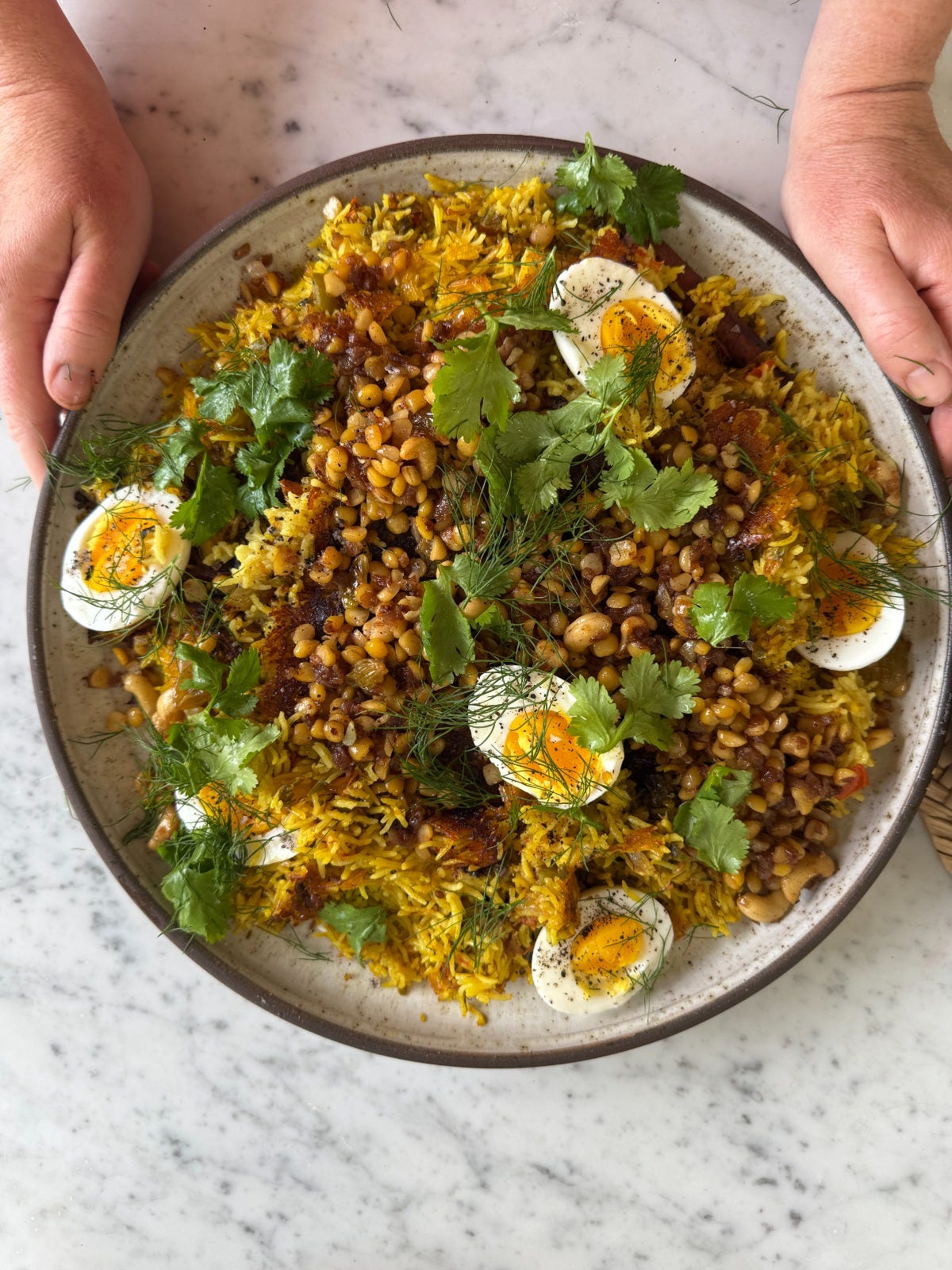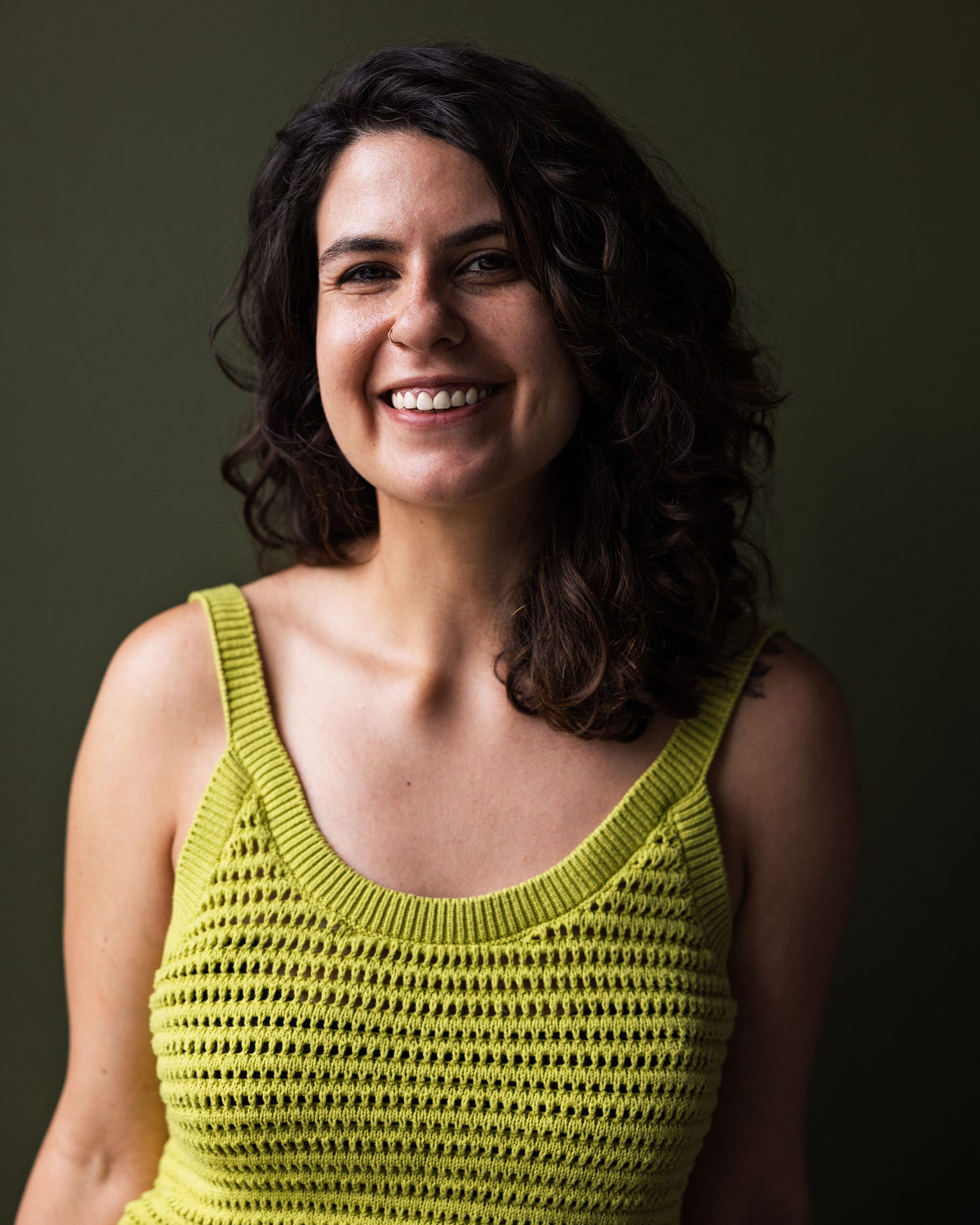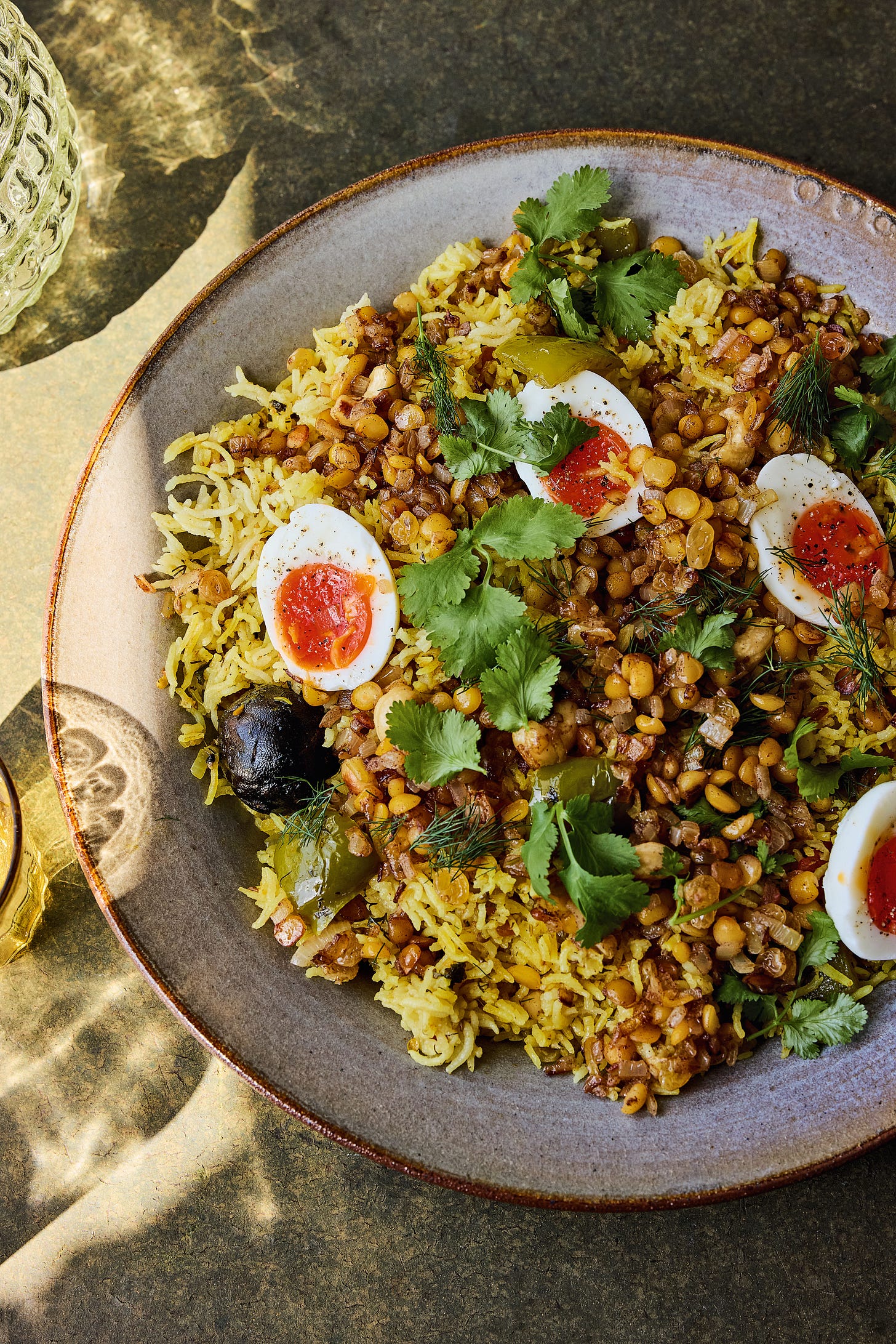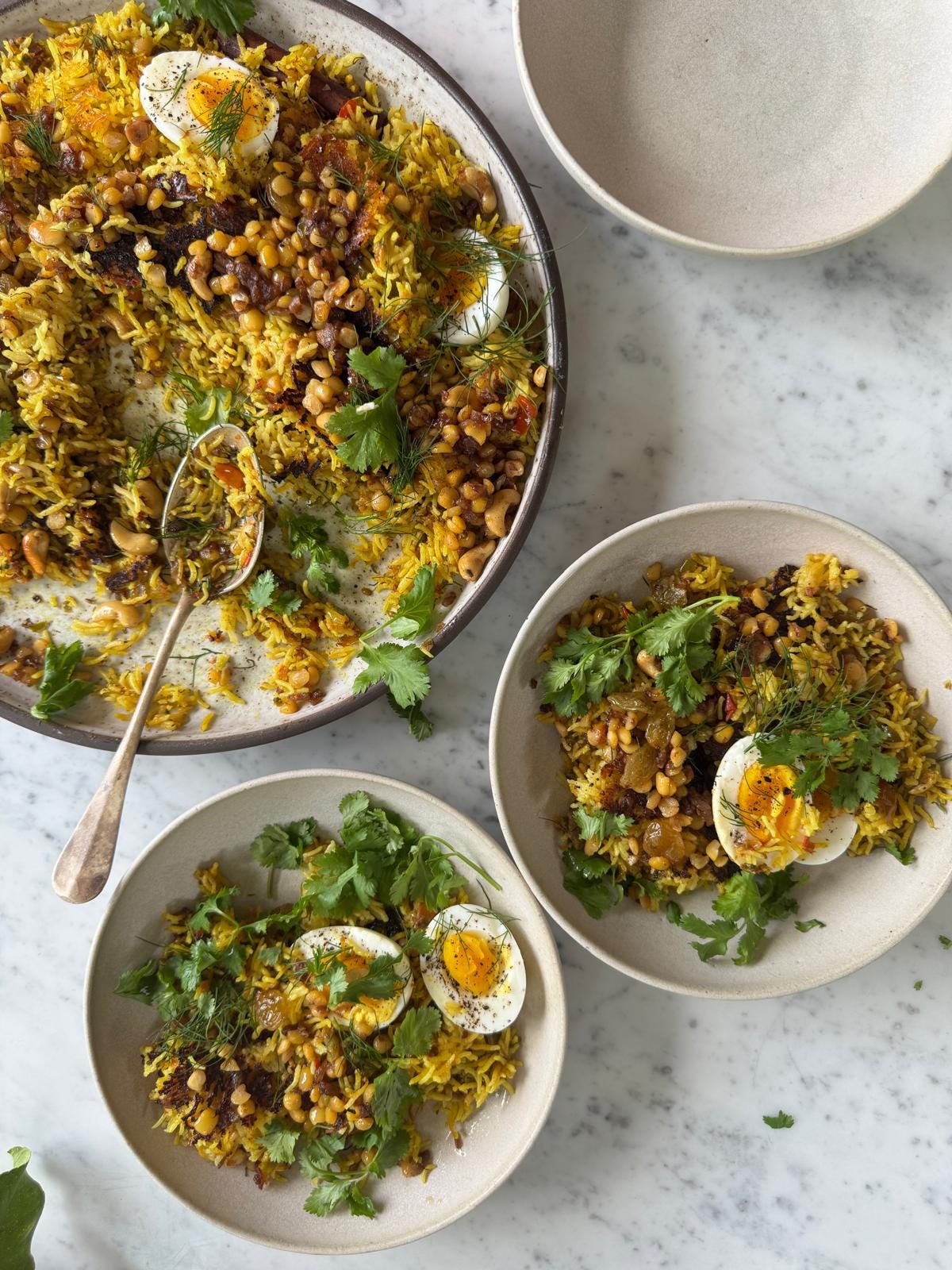Hi and welcome to my newsletter, a celebration of cooking, vegetables and life. It’s great to have you here. If you have found yourself here but are not yet subscribed then you can sort that out below….
My cookbooks (there are five) are available here. The latest is Easy Wins - a Sunday Times bestseller. There are hundreds of free recipes on my website which you can find here. I am a proud patron of TastEd, which exists to change food education for good.
From Anna
Once a month I hand my newsletter over to another voice whose food and writing is worthy of your attention. This month, I am so pleased to have Noor Murad sharing her food and thoughts with us. Noor is a Bahraini-British cook and writer whose words (and recipes) I love to read. Her book Lugma had me so entranced when I first opened it. Noor’s food feels new and exciting (to me) but is so clearly rooted in the traditions and memories of her home. Middle Eastern food has become part of how we eat in the UK and US but until I read Lugma and chatted with Noor over lunch, I’d not realised that I had missed so much of the food of Bahrain. It has not been celebrated nearly enough in my kitchen. Noor is putting the food of Bahrain firmly on the map for those of us who haven’t yet explored it, and how lucky we are that she is.
Last week, coincidentally just before Eid, I made the Machboos recipe which Noor has generously shared with us. A deeply spiced rice dish with a crispy bottom (like tadig) and a very clever topping of split peas, cashews, more spice and very importantly, a splash of vinegar which all comes together to make something that feels so individual and so so good.
Thank you Noor for your book and your writing, and for sharing the food of your home with us all. My kitchen and my heart are richer for it.
From Noor
I always say that I’m half Victoria sponge and half machboos (a spiced rice dish). This either makes people smile or leaves them very confused but I always found it the most fitting description for the way I straddle both my East and my West in cooking and in life.
I’m a Bahraini-British cook and author born and raised in Bahrain to an Arab dad and an English mum and only moved to the UK in my late twenties. I started working in food when I was a teenager, having worked at Bahrain’s formula-1 track and Jean Georges restaurant in New York but most people know me for my past work at Ottolenghi and for having co-authored the two Ottolenghi Test Kitchen cookbooks. Through my work and living in the UK, I found that although Middle Eastern food had become quite popularised in the West, there was a lack of representation of certain parts, in particular my own.
I’ve always believed that the Middle East should be its own continent, that it’s impossible to paint the whole region with one brush when its offerings are so wonderfully vast, diverse and colourful. When I set out to work on my debut solo cookbook Lugma, I did so with the intention of highlighting the foods of my small but mighty Island Bahrain, its food a medley of Arabic, Persian and Indian flavours, while also balancing my two cultures with a mixture of traditional and reimagined recipes. The result is exactly as I’ve always known Middle Eastern food to be: herb-heavy, spice forward, citrus-lead and always served with generosity and abundance. With Lugma now out in the world, I’ve come to realise its importance in celebrating Arab culture and how one small voice can indeed make a difference (and even popularise black limes among the masses).
Things to add to your pantry:
Black limes:
As if I haven’t put a plug in for black limes already but if you’re unfamiliar with this ingredient then I encourage you to integrate them into your cooking. They are basically limes that have been sun dried and come in either a lighter yellow/brown colour or a dramatic black. They’re the backbone of cooking throughout the Persian Gulf, Iran and Iraq and have a really unique, earthy, bitter flavour that can’t really be replicated with the squeeze of a fresh lime. There’s a myriad of ways in which you could use them, which are sprinkled throughout Lugma but you can drop them into soups, stews, rice dishes, use them as a marinade, to make tea or even integrate them into desserts. You can find them in most Middle Eastern or Turkish grocery stores, or here.
Date syrup:
Quite literally nature’s caramel, I use date syrup a lot in my cooking but I especially love it drizzled onto my morning porridge with tahini. I also use it instead of treacle when making sticky toffee pudding, as I find I only ever use treacle for this one dessert, whereas I can use date syrup in so many ways! Buy it here.
Things to listen to:
Desert Island Dishes:
A great podcast that includes some amazing guests and gives you the best dinner inspo. Trigger warning: do NOT listen to this when hungry!!
The Dinner Plan:
A recent addition to my food podcasts and I enjoy the different conversations that Maggie has with all the cooks that come onto her show, especially with her questions on what most chefs will have for an easy, no fuss dinner.
Things to Read:
Scribehound food:
A new platform that I’m proud to be a part of, Scribehound provides you with a daily article from different authors discussing our favourite topic - food! If you’re tired or overwhelmed from the social media food noise and appreciate the written word, then this is the place for you. Just last month there were discussions about wild food, the club sandwich, everyone's favourite potato crisp, the juice of a lemon and social awkwardness in the food world to name a few.
Machboos
Machboos is Bahrain’s national dish, a spiced rice that will often contain meat or fish. This ‘base’ recipe can be made with any protein you choose, but I also like to have it as is and instead take liberties with the toppings. The split pea and onion topping is often seen at special occasions, for instance during Eid, when you’ll have a whole lamb over rice (called ghouzi).
Serves 4–6
Soaking time: 20 minutes–2 hours
For the rice
55g (2oz) ghee (use olive oil if vegan)
1 onion, finely chopped (180g/6¼oz)
1 cinnamon stick
1 dried lime (black or regular), pierced a couple of times with a sharp knife (optional)
1 green (bell) pepper, cut into 3–4cm (about 1½in) cubes
4 garlic cloves, finely grated
30g (1oz) fresh ginger, peeled and finely grated
1–2 green chillies, finely chopped, seeds and all
1½ tsp cumin seeds, finely crushed using a pestle and mortar
1½ tsp coriander seeds, finely crushed using a pestle and mortar
4 cloves, finely crushed using a pestle and mortar
8 cardamom pods, roughly bashed open
½ tsp ground turmeric
200g (7oz) tomatoes, finely chopped (about 2 small ones)
10g (¼oz) dill fronds, finely chopped
10g (¼oz) coriander (cilantro) leaves and soft stems, finely chopped
300g (10½oz) basmati rice, washed until the water runs clear, then soaked for at least 20 minutes and up to 2 hours, then drained
fine sea salt and ground black pepper
For the topping
75g (2½oz) yellow split peas, soaked in boiling water for 2 hours
3 medium eggs, boiled to your liking, then peeled (omit if vegan)
25g (1oz) golden raisins
1 tbsp apple cider vinegar
1 large onion, finely chopped
35g (1¼oz) raw cashews
40g (1½oz) ghee (use olive oil if vegan)
½ tsp ground cinnamon
5g (1/8oz) coriander (cilantro), leaves and soft stems picked
5g (1/8oz) dill fronds, picked
Melt 40g (1½oz) of the ghee in a large, lidded saucepan over a medium-high heat. Once hot, add the onion, cinnamon stick and dried lime and fry for 4 minutes, stirring occasionally, until softened and starting to colour. Add the green pepper and continue cooking for 3 minutes, stirring occasionally, then add the garlic, ginger, chillies and spices and fry for a minute more, until fragrant. Stir in the tomatoes and herbs and cook for 5 minutes, stirring occasionally, until the tomatoes have completely broken down. Stir in the rice, 1¼ teaspoons of salt and a generous grind of black pepper, then pour in 500ml (17fl oz) of hot water. Bring to a simmer and dot with the remaining 15g (½oz) of ghee. Cover the pan with a clean tea towel followed by the lid, bringing the ends of the towel up and over the lid and securing them with a rubber band or by tying them together. Turn down the heat to medium-low and leave to cook, undisturbed, for 20 minutes. Once ready, turn off the heat and, without removing the lid, leave to steam for a further 20 minutes.
Meanwhile, prepare the topping. Three-quarters fill a medium saucepan with water and bring to the boil. Add the drained split peas to the pan and boil for 15–20 minutes, or until they are cooked through but still hold their shape. Drain well and set aside. Refill the saucepan with water and use it to boil your eggs at this point. Cool, peel and set aside.
Add the golden raisins and apple cider vinegar to a small bowl and set aside. Place a medium frying pan (skillet) over a medium-high heat. Once hot, add the onion and the cashews (without any fat at this point) and fry for 6 minutes, stirring occasionally, until nicely browned. Add the ghee and cinnamon, stirring to melt the ghee, then stir in the split peas, 1/3 teaspoon of salt and a good grind of pepper. Fry for a further 4 minutes, stirring occasionally, then add the golden raisins and vinegar and remove from the heat
Uncover the rice, remove the towel and place a large, round platter over the pan. In one swift movement, invert the whole thing onto the platter, gently shaking the platter and using a spoon to spread everything nicely. Spoon over the split pea mixture, then halve the eggs, seasoning them with a pinch of salt and pepper, and arrange these on the rice too. Lastly, top with the picked herbs.









Super beautiful things!!! I'm inspired🔥